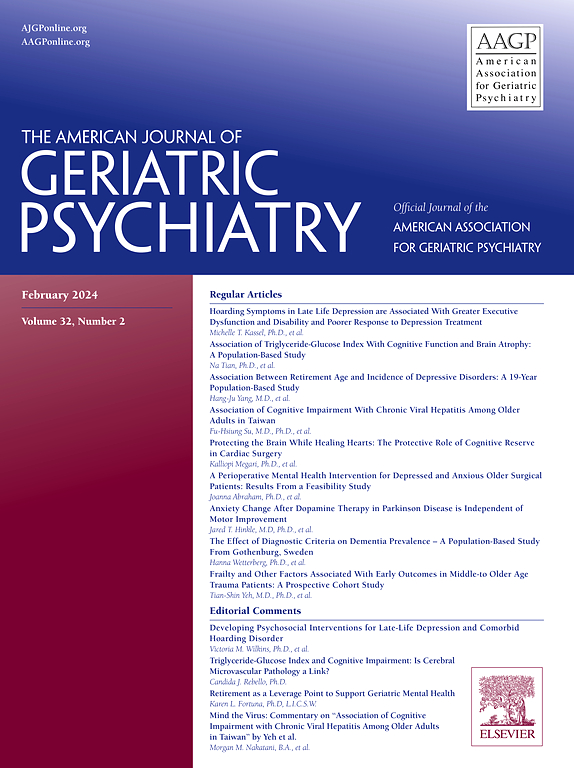6. 晚年抑郁的潜在方面:探索童年创伤和人格的作用
IF 3.8
2区 医学
Q1 GERIATRICS & GERONTOLOGY
引用次数: 0
摘要
在老年人群中,儿童期创伤的发生率即使不高于中年或青年,也同样高,许多估计在15-45%之间。对于那些有抑郁症病史的人来说尤其如此。尽管如此,老年病学家、精神科医生和心理学家仍然把注意力集中在与典型衰老相关的情绪恶化和可能的抑郁的急性方面(例如,功能限制、身体健康下降和人际关系丧失等),而忽略了一个人过去和现在表现的抑郁的两个重要方面:童年创伤和基线人格特征。我们试图调查神经质——与精神病理学最相关的人格变量——和童年创伤是否以及在多大程度上与一个人的抑郁史有关。方法对99例55 ~ 79岁成人(M年龄 = 65,SD = 6.5)进行DSM-5 (SCID-5)结构化临床访谈,其中61例为无抑郁(N-DEP), 38例为35岁前首次发病的至少一次抑郁发作(DEP)(包括活动性和缓解性)。所有参与者均接受NEO人格量表(NEO- pi)和童年创伤问卷(CTQ)。有两个主要结果:描述老年人样本中儿童创伤的患病率和构成,以及调查其与个性变量和个人抑郁症史的关系。进行了探索性分析,以了解儿童创伤类型是否唯一地预测抑郁发作。线性混合模型,包括层次回归,用于该分析,并根据年龄,性别和教育程度进行调整。结果在我们的样本中,大多数从未抑郁过的参与者,54%的得分超过35分,这是CTQ临床意义的典型阈值,其中性虐待分量表得分超过阈值的比例最低(22%),情感忽视得分最高(55%)。此外,当比较N-DEP组和DEP组时,我们发现DEP组的情感虐待几乎是前者的3.5倍,身体虐待几乎是后者的3倍。神经质小面评分(输入第二组)可预测抑郁史(p < 0.001),但儿童创伤评分(输入第三组)不能预测抑郁史。最后,在五个子量表中,只有情绪虐待对模型有显著影响(block 3,取代整体CTQ分数;P = 01)时输入自己的模型步骤。结论:大多数样本报告得分被认为具有临床意义,证实了我们的假设,即这些经历可能比以前怀疑的更常见。此外,我们的研究结果强调了在晚年治疗成人情绪症状时,给予基于特征的变量的重要性——主要是被标记为神经质的人格方面。事实上,童年创伤得分总体上对模型没有显著贡献,这可能与样本中创伤的高基线存在有关,而不管抑郁史如何。最后,情感虐待在区分群体和预测群体分配方面的独特定位,突出了对儿童创伤对老年人影响的进一步研究的必要性。本文章由计算机程序翻译,如有差异,请以英文原文为准。
6. LATENT ASPECTS OF LATE-LIFE DEPRESSION: EXPLORING THE ROLE OF CHILDHOOD TRAUMA AND PERSONALITY
Introduction
The presence of childhood trauma in the geriatric population is as high, if not higher than those in middle age or young adulthood, where many estimates range from 15-45%. This is likely especially true among those with history of depression (LLD). Still, geriatricians, psychiatrists, and psychologists often remain focused on the acute aspects of worsening mood and possible depression tied to typical aging (e.g., functional limitations, declining physical health, and interpersonal losses, etc.) neglecting two important aspects of a person’s depressive past and current presentation: childhood trauma and baseline personality characteristics. We sought to investigate if, and to what extent, neuroticism – the personality variable most implicated in psychopathology – and childhood trauma relate to a person’s history of depression.
Methods
99 adults aged 55-79 (M age = 65, SD = 6.5) were administered the Structured Clinical Interview for DSM-5 (SCID-5) and categorized as 61 never-depressed (N-DEP) and 38 with at least one depressive episode (DEP) with a first onset before the age of 35 (including active and remitted). All participants were administered the NEO Personality Inventory (NEO-PI) and the Childhood Trauma Questionnaire (CTQ). There were two primary outcomes: to describe the prevalence and make-up of childhood trauma in a sample of older adults and to investigate its relationship with personality variables to an individual’s history of depression. Exploratory analyses were conducted to see if the type of childhood trauma uniquely predicted depressive episodes. Linear mixed models, including hierarchical regression were used to for this analysis and were adjusted for age, sex, and education.
Results
In our sample with a majority of never-depressed participants, 54% scored over 35, the typical threshold for clinical significance on the CTQ, with the sexual abuse subscale receiving the lowest amount of suprathreshold scores (22%) and emotional neglect being the highest amount (55%). Further, when comparing between N-DEP and DEP groups, we found nearly three and a half times as much emotional abuse and nearly three times as much physical abuse in the DEP group. Neuroticism facet scores (entered in the second block) were predictive of depression history (p LESS THAN .001), but childhood trauma scores (entered in the third block) were not. Finally, of the five subscales, only emotional abuse was a significant contributor to the model (block three, replacing overall CTQ scores; p = 01) when entered in their own model steps.
Conclusions
The majority of the sample reporting scores considered clinically meaningful confirmed our hypothesis that these experiences are likely more common than previously suspected. Further, our results highlight the importance of giving trait-based variables – principally, the facet of personality labeled neuroticism – consideration for treating adult mood symptoms in late life. The fact that childhood trauma scores overall did not significantly contribute to the model may be related to the high baseline presence of trauma across the sample, regardless of depression history. Finally, the unique positioning of emotional abuse, both in differentiating the groups and in predicating group assignment highlights the need for further research on the impact of childhood trauma in older people.
求助全文
通过发布文献求助,成功后即可免费获取论文全文。
去求助
来源期刊
CiteScore
13.00
自引率
4.20%
发文量
381
审稿时长
26 days
期刊介绍:
The American Journal of Geriatric Psychiatry is the leading source of information in the rapidly evolving field of geriatric psychiatry. This esteemed journal features peer-reviewed articles covering topics such as the diagnosis and classification of psychiatric disorders in older adults, epidemiological and biological correlates of mental health in the elderly, and psychopharmacology and other somatic treatments. Published twelve times a year, the journal serves as an authoritative resource for professionals in the field.

 求助内容:
求助内容: 应助结果提醒方式:
应助结果提醒方式:


